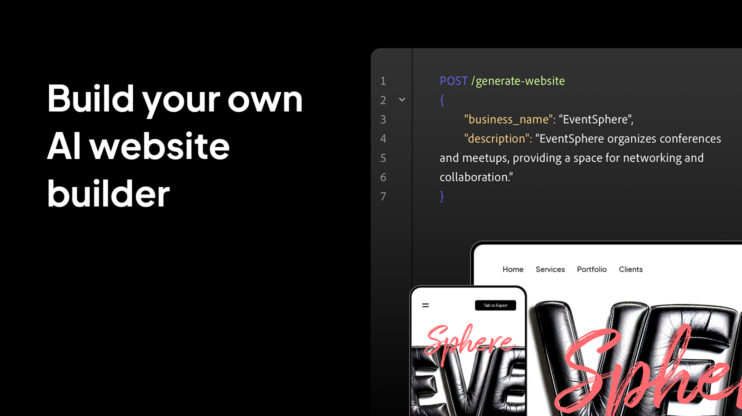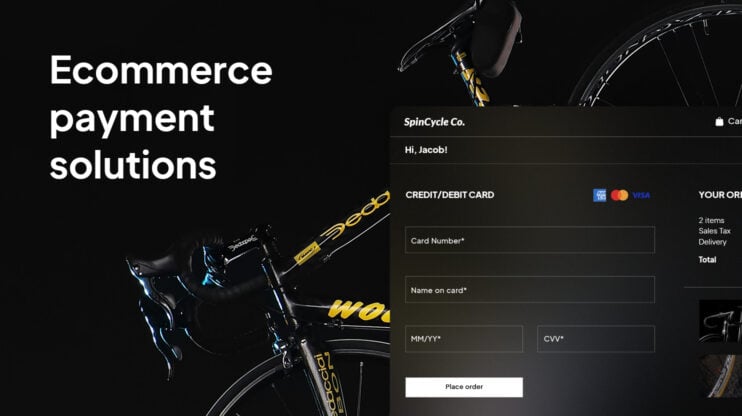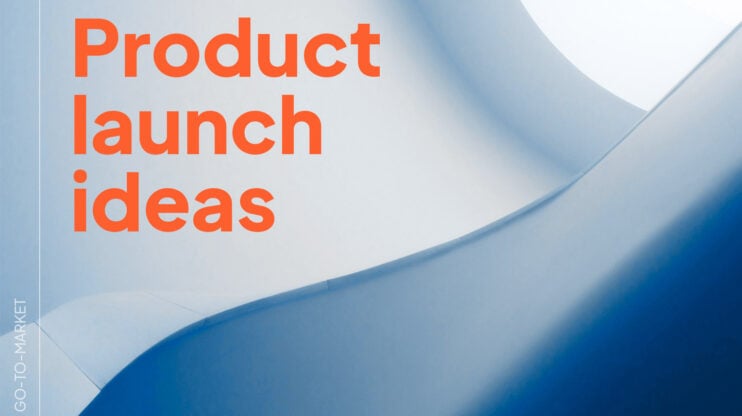You’re building a SaaS product or platform, and your favorite stakeholder has heard that the best thing to do is “add AI.” Now, it’s up to you to implement this idea as a quick little side project. No pressure, though!
There’s some good news. You don’t need to reinvent your backend or assemble a crack team of elite ML engineers (although that certainly could help). With the right AI APIs for SaaS companies, you can quickly integrate valuable features like natural language processing (NLP) and generative text into your platform. White-label APIs will even let you brand the experience as your own and roll it out at scale.
In this guide, we’ll show you how SaaS companies are actually using AI APIs to move faster, add value, and stay competitive. You’ll learn the key use cases, what to look for in an AI API (especially if white-labeling a mature product is on your radar), and why our Website Builder API might be the shortcut you’ve been looking for.

Launch branded websites at scale
Add scalable, AI-powered WordPress site generation to your product - under your brand, on your terms.
The current outlook on AI APIs for SaaS companies
AI APIs are like power-ups for your SaaS product. Instead of building natural language processing, image generation, or website creation tools from scratch, you connect to a pre-built API and instantly unlock advanced functionality.
You skip the heavy lifting of model training, infrastructure scaling, and ongoing AI maintenance. The provider handles the machine learning. You focus on delivering value to your users.
For SaaS companies, that’s a compelling concept. It means you can:
- Launch new features faster (smarter onboarding, automated content, dynamic UIs).
- Compete with larger platforms by embedding AI into core workflows, products, and services.
- Expand your product roadmap without expanding (or overtaxing) your dev team.
Whether you’re building for end users, internal ops, or agency clients, AI APIs let you add intelligence without reinventing your architecture. And when that API is white-label friendly, you don’t just integrate a tool — you add real value and new capabilities to your products and services.
Top use cases of AI APIs for SaaS companies
AI APIs aren’t just for flashy demos. They’re solving real product and workflow problems across SaaS platforms. Right now, the best AI APIs for SaaS companies have a high profile across various use cases.
1. Conversational AI and chatbots
Integrate AI-powered chat to reduce support load, guide onboarding, or offer personalized help. NLP APIs like OpenAI or Anthropic can give your bot real context, not just scripted replies.
2. Image and video generation
APIs for text-to-image (like Stability.ai) or background removal (like remove.bg) are helping SaaS tools enhance visual content creation for users, from social scheduling apps to ecommerce design tools.
3. Analytics, forecasting, and personalization
These AI APIs for SaaS companies provide predictive data to spot churn, customize dashboards, or suggest the most effective actions. AI-driven personalization, particularly in dashboards or SaaS customer relationship management (CRM) systems, can significantly improve retention and perceived value.
4. Website and page generation
This is where things have gotten really interesting. SaaS platforms or agencies that offer website development, digital marketing services, online presence management, or the like are automating and expanding with solutions like the Website Builder API. Imagine creating workflows that launch a landing page or dashboard for each user at signup. All with no manual lift, full customization, and white-label control.
Challenges in adopting AI APIs
Even with the promise of speed and scalability, adopting an AI API isn’t always a plug-and-play process. For product owners and development teams, a few practical concerns tend to arise early, and smart solutions can make or break adoption.
1. Data privacy and compliance
Especially in finance, healthcare, or B2B SaaS, pushing customer data through a third-party API raises significant concerns. One solution (depending on your risk level) is to choose APIs that support on-premise hosting, secure endpoints, or client-side processing.
2. Integration complexity
Docs can be vague. Endpoints evolve. Some APIs feel like you need a PhD to get started. Look for providers with clear, modular docs, frontend-ready SDKs, and hands-on support.
3. White labeling and UI control
Your product is your brand, so tacking on a third-party UI could break trust. Not all APIs are white-label ready. Prioritize APIs that allow complete branding control, custom styling, or return raw data or HTML that you can inject into your own flows.
4. UX consistency and API downtime
No one wants their core feature to go dark because of a provider issue. Vet providers for uptime SLAs, rate limits, and error fallback strategies. Build for resilience, and make sure the AI doesn’t become the weakest link in your UX.
Pro tip: One reason dev teams love 10Web’s Website Builder API is its clean JSON structure and UI flexibility. It returns just what you need, ready to style and ship under your domain.
How to choose the right AI API for your SaaS
Not all AI APIs are built for SaaS. Some are designed for one-off projects or internal tooling. If you’re building a product or service that people rely on daily, your API partner needs to meet a higher bar.
1. Developer experience (DX)
Documentation shouldn’t feel like a riddle. Look for APIs with:
- Clear, up-to-date docs
- Usage examples in docs
- Easy auth and sandbox testing
- SDKs or client libraries that save setup time
2. Flexibility and customization
Can you tweak the output? Control styles? Inject your own logic? Whether it’s generating text, images, or full websites, the best APIs give you granular control over inputs and outputs so the result fits seamlessly into your product.
10Web’s API, for instance, lets you define layout structures, insert branded sections, and prefill content based on your customer data.
3. Scalability and performance
APIs that work for one user might buckle at 1,000. Check for:
- Rate limits and batching options
- Parallel processing capabilities
- Region-specific hosting (if needed for compliance)
- Monitoring or analytics endpoints
The more your usage grows, the more scalability and performance matter.
4. Security and data handling
Privacy isn’t optional and is increasingly scrutinized by lawmakers. Make sure your provider covers the basics:
- Uses HTTPS and encrypted storage
- Offers data deletion options
- Has transparent policies on data usage (especially if AI models are retrained on your data)
5. White-label capability
If user trust and experience are part of your product promise, you can’t afford to have third-party branding displayed. Confirm whether:
- You can host results on your domain
- The UI is entirely yours (or raw data is returned for custom rendering)
- There are any “powered by” requirements in the terms
Retain control with white-label AI APIs for SaaS companies
AI APIs are impressive, but if your customers see someone else’s logo or land on a third-party domain, it instantly erodes trust.
That’s why white-label AI APIs for SaaS companies matter. They let you integrate powerful functionality while maintaining a seamless, branded experience. Your users stay inside your flow. Your product gets all the credit.
For SaaS builders and agencies, this unlocks real advantages:
- Trust and professionalism: You control the UX, UI, and domain. No “powered by” tags. No redirects.
- Monetization flexibility: Bundle features into plans, create new SKUs, or charge per use, all under your own brand.
- Scalability: Generate dozens or thousands of websites, pages, or user portals without adding headcount.
- Client retention: Agencies leveraging white-label solutions become more deeply embedded in their clients’ growth. You’re not just providing one service but also fulfilling a need for clients or users who require genuine solutions.
And the technical side? That’s where 10Web’s Website Builder API comes in.
You get full control over:
- Structure and styling – define templates, layouts, and flows
- Content – prefill based on user inputs or business type
- Domain and hosting – keep everything under your brand
So, instead of building a website builder from scratch, you get the outcome. AI-generated websites, delivered under your roof, your logo, and your business model.
Integration in action – how the 10Web Website Builder API works
You’ve seen what AI APIs for SaaS companies can do. But how do you actually integrate one into your platform, product, or agency workflow?
Let’s walk through a high-level example using the 10Web Website Builder API, which allows you to:
- Use AI to generate WordPress sites on demand
- Pre-configure new sites with your choice of plugins, templates, styles, and more.
- Provide managed hosting services with a white-label dashboard for clients
- Manage domains, DNS, and SSL, and more.

Sell Hosting Under Your Own Brand
Launch fully managed WordPress sites with your logo, pricing, and dashboard!
Use case example: Auto-create a website during onboarding
Let’s say you run a SaaS platform for marketing professionals. When a new user signs up, you want to instantly create a branded website for their business based on a few simple inputs.
With the 10Web API, you have two options:
- Create a new site using your choice of pre-selected plugins and styles, or
- Generate a new site with the AI Website Builder
To create a blank WordPress website:
Step 1. Create the endpoint…
POST https://api.10web.io/websites
and send the headers:
x-api-key: YOUR_API_KEY
Content-Type: application/json
Step 2. Pass the site credentials in the body:
{
"subdomain": "lightworks-studio",
"region": "us-west",
"site_title": "Lightworks Studio",
"admin_username": "lightworks_admin",
"admin_password": "Lightworks2024"
}
Or use AI to generate a new website based on user data:
Step 1. Endpoint:
POST https://api.10web.io/websites/ai-generate
Headers:
x-api-key: YOUR_API_KEY
Content-Type: application/json
Step 2. Include your text prompt in the body:
{
"domain_id": 123456,
"business_type": "photography",
"business_name": "Lightworks Studio",
"business_description": "An elegant photography studio that showcases creative portfolios and helps capture leads through visually appealing and professional imagery."
}
The API responds with a complete website, including its structure, styled pages, and suggested content, all of which are editable and ready to launch under your brand.
Clients need more than just a website
From this point, you can upsell on hosting, domains, and a white-labeled AI Website Builder to create a comprehensive, in-demand solution for clients.
You’re not just integrating a feature, although the API is a simple way to drop in an AI website builder. You’re augmenting your solution with an AI-powered platform that allows you to deliver value and fill a broader service gap for clients.
- A finished product your users can immediately use
- A branded experience your platform wholly owns
- A scalable service you can bundle, upsell, or automate
Start shipping smarter with AI APIs built to scale
AI isn’t just for tech giants anymore. With the right API, your SaaS product or agency can deliver smarter, faster, and more scalable experiences without bloated sprints or extra headcount.
Whether you’re personalizing dashboards, auto-generating landing pages, or giving clients full websites in seconds, AI APIs open the door to real product differentiation.
But features alone aren’t enough. You need:
- White-label control
- Fast, flexible integration
- A user experience that feels like yours from start to finish
That’s where the 10Web Website Builder API fits in. You bring the user. We help you launch their website, under your brand, at scale.
Try it free for 7 days and see how easy it is to integrate an AI-powered website builder into your workflow.

Request your API demo now
See how easy it is to integrate AI website generation into your platform!
FAQ
Can I fully white-label the 10Web Website Builder API?
Yes. The entire user experience, domain, design, content, and dashboard can be customized to live under your brand. There are no “powered by” tags, no redirects, and no third-party interfaces to break the trust you’ve built. Whether you’re embedding it into a platform or reselling it as part of an agency package, the result looks and feels like your product from start to finish.
How much development time is required to integrate the API?
If you’ve worked with REST APIs before, you’ll be up and running in a day. The 10Web API uses straightforward HTTP endpoints with clear JSON payloads and includes practical docs to walk you through everything from site creation to AI generation. No DevOps setup. No custom SDKs. Just plug in, test, and go.
Why do SaaS platforms choose AI APIs instead of building AI in-house?
Building machine learning features from scratch can take months, and hiring a full AI team doesn’t always make sense for lean product organizations. AI APIs let you add smart functionality (like content generation, personalization, or full site creation) using proven models, without distracting your dev team or slowing your roadmap.
What are some real examples of AI APIs in SaaS?
It doesn’t take much to find examples of AI APIs in SaaS companies. Chatbots powered by OpenAI, image tagging through Google Vision, transcription with AssemblyAI, or AI-powered platforms like 10Web have become mainstream in a relatively short time. These tools help SaaS products ship smarter features, faster, by outsourcing the AI layer and focusing on what matters most: user experience.













